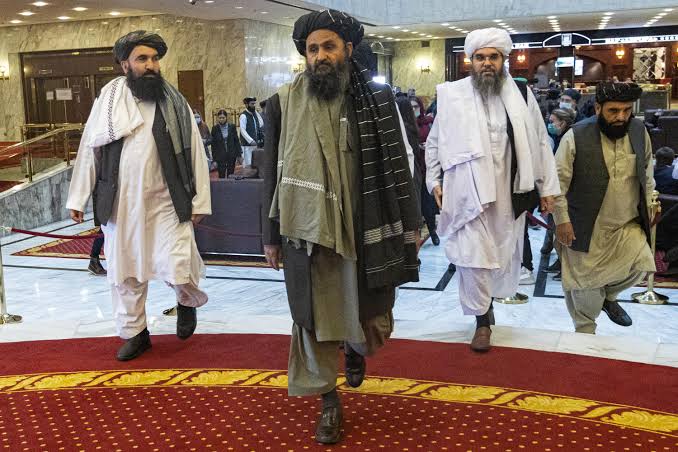For India no alternative to engaging with the Taliban
Taliban delegations have been hosted by China, Iran, Russia, Uzbekistan, Turkmenistan demonstrating the group’s diplomatic outreach. India, with it’s over 3 billion development aid to Afghanistan seems to be the only odd one out in the region.

By Aditi Bhaduri
As Minister of External Affairs Dr. S. Jaishankar visits Moscow we have no idea if he will be meeting with any Taliban representatives there. Earlier the Ministry had rejected reports of the minister meeting with Talibani representative on his sudden short stopovers in Doha. But it does seem curious that while Jaishankar was in Tehran a day ago a Taliban delegation happened to visit there and now when Jaishankar is in Moscow a delegation of the Taliban are visiting as well. Without wasting time speculating it can only be said that India should not be shy if it would s engaging any section of the Taliban.
For that remains the only sagacious option.
The writing had long been on the wall. If Donald Trump could have thumped his way to electoral victory in 2016 with ending the Afghan war being one of his major electoral promises then it is hard to envisage that the current administration of Joe Biden would do anything different.
While the US remains committed to funding humanitarian projects and the military there in his speech yesterday outlinig America’s Afghanistan policy President Joe Biden made it clear that “Afghan leaders have to come together and drive toward a future,” he said. “It’s the right and the responsibility of the Afghan people alone to decide their future and how they want to run their country.”
In others words, as long as they are Afghans, it makes little difference to America who and how Afghanistan is run so long as America is not threatened. The American funding will seek to secure this.
Meanwhile the Taliban are on the march, having taken over large swathes of the country, as much as 85 per cent, according to Taliban negotiator Shahabuddin Delawar, speaking at a press conference in Moscow on Thursday, July 8. Even if exaggerated, this does not come as a surprise.
The Taliban have long been on the ascendancy. Already by 2017 they were in control of 40 per cent of Afghan territory, even if much of it was unpopulated. And in 2016 then Afghan Ambassador to India Dr. Shaida Abdali had told this author “We do not see the ‘good’ or ‘bad’ Taliban. What we do see is the reconcilable and the irreconcilable Taliban.” It meant that the Taliban had not just become a force to be reckoned with but a political stakeholder as well in spite of the US-led war.
Along with steadfast support from Pakistan, the Taliban had also been helped by the fractious government in Kabul and the pervasive corruption. By 2013 Qatar had allowed them to open an office in Doha much to the chagrin of then Afghan President Hamid Karzai. By 2017 Russia, China, Iran had all come around to accepting the Taliban as a legitimate stakeholder in Afghanistan politics and peace. As ISIS fighters began getting a foothold in Afghanistan it’s neighbours and other powers in the region concluded that the Taliban were more capable of fighting the Islamic State; their intelligence concluded that the Afghan government would ultimately fall. A top diplomat from a Central Asian country had this to say about the Taliban recently: “They are Afghans and have a role to play in Afghanistan’s politics. They are not the old Taliban, they have evolved and learnt how to live with the world.”
It’s a miracle that India did not begin recalibrating it’s Afghan policy then.
Finally, in February 2020 the US concluded the Doha peace accords not with the Ashraf Ghani government but with the Taliban. Since then, the Taliban have only moved to a position of strength, albeit much if it through violence. They have taken over Afghanistan’s border crossing with Tajikistan last week, effectively capturing the supply lines from Tajikistan to northern Tajik Afghan territory traditionally stronghold of the Northern Alliance which had received aid from India, Russia and Iran via Tajikistan. Now the Taliban have also taken over some border crossings with Iran. More than half of the Afghan districts are now Taliban territory. The takeover also demonstrates that the Afghan National Defence Forces have been unable to thwart the onslaught.
Meanwhile the USA left Afghanistan’s Bagram Airfield after nearly 20 years by slipping away in the night without notifying the base’s new Afghan commander.
The intra-Afghan negotiations are deadlocked over the formation of aninterim government – a key Taliban demand and one which the Ghani government is keen to avoid. The day Jaishankar was lecturing on India-Russian ties at the Primakov Institute of World Economy and International Relations his Russian counterpart Sergei Lavrov was reported as saying at a lecture at the Fareastern Federal University that the Taliban belligerence was due to the fact that the formation of an interim government was being stalled by the Kabul government. In other words, the responsibility for Taliban violence was placed on the Kabul government’s intransigent position vis-a-vis an interim government.
Taliban delegations have been hosted by China, Iran, Russia, Uzbekistan, Turkmenistan demonstrating the group’s diplomatic outreach. India, with it’s over 3 billion development aid to Afghanistan seems to be the only odd one out in the region. Given the geopolitical shifts in Afghanistan it is in India’s interest to drop the obduracy of not being seen to be engaging with the Taliban. Here it can take a leaf from the Russian policy book towards the Taliban. In Moscow the Taliban gave assurances that “it will not allow any one to use the soil of Afghanistan against any other country, nor will tolerate intervention of others”. It is time for India to take the Taliban at its word. There is hardly any other option. India’s massive development aid should act as a good guarantor of its security.